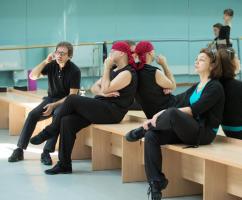Continuation of Reflections on Répétiteurs
The performance has ended. The cries of “Bravo!” and applause have ended. The curtain has closed. On stage, the leading dancers are receiving congratulations and compliments. Beside them are their répétiteurs.
A discussion begins, an analysis: what went well today, what should be looked at in a scene, whether technically or artistically, and what to focus on in preparation for the next performance. The work continues.
Who is a répétiteur, often called a coach, balletmaster, sometimes a teacher, preparing the role with the dancer, the lead part? What is required to prepare a dancer, to create a vivid image with them, to find the right technical elements? Great experience, knowledge, an understanding of the style and era of the performance. Mastery of pedagogical knowledge for preparing the elements of classical dance. I think all this cannot be described in words. Our art—classical ballet—combines a vast number of components, the knowledge of which is passed down from one generation to another, “hand to hand.” Mastery of these components and a deep understanding of a ballet performance make our répétiteurs unique people in the art. One of the répétiteurs recently told me, “The right to be and to be called a coach must be proven every day.”
What does it mean to prepare a lead role in ballet with a dancer? To prepare, not just to put on stage a dancer who doesn’t understand what they are performing or why they are there, and only to see a couple of cleanly executed technical elements, jumps, or turns, which often carry over from one performance to another and frequently do not match the style. To prepare a role, not just to learn a set of movements choreographed, often replacing half of the unsuccessful elements, thinking that the choreographer is either long dead or, if alive, not great and will not notice.
I love watching the work of a répétiteur with a dancer. The emergence of a new hue, nuance in what seemed to be a familiar and well-known combination of classical dance movements. The search for a successful angle for a pose, a jump, the beautiful height of the arms for the dancer, the angle of the head. The analysis of technical elements, and sometimes the search for completely new ones. Such work does not pass without nerves, frustration from things not working out, anxiety that there will not be enough time before the scheduled performance date, fatigue… And suddenly, something new lights up in the solo, duet, variation, or monologue. The first bright moments of the role appear, the image is born…
The stage. Applause. The curtain… And once again with the répétiteur, an analysis of the past performance and the continuation of work.
During the staging of new performances, the répétiteur is present at the staging rehearsals, sensitively and attentively immersing in the concept and style proposed by the choreographer, memorizing the suggested choreographic text. I often notice how répétiteurs ponder, squinting, already passing through themselves what they liked or trying to understand what somehow did not match. I love their questions, sometimes doubts. The conversation, the search, the joy of collaborative work.
Répetiteurs. People so invisible to the audience, who have prepared the dancers and the performance for the meeting with the audience and remain behind the scenes… People without whom ballet theater, our art, is unthinkable.
© Konstantin Uralsky
